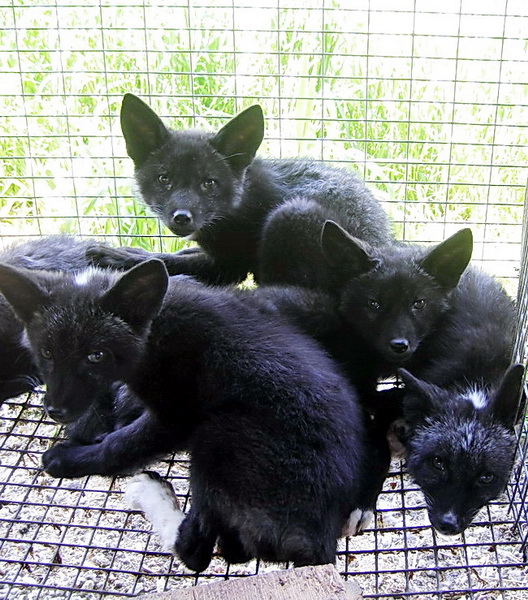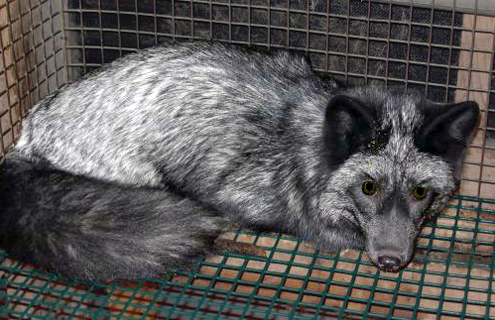 |
| Colors of mink pelts (c) Fur Commission |
Pelt quality consists of several traits. The most important quality factors are
- flaws (such as bite marks)
- the quality of the guard hairs
- the quality of the undercoat
The third important quality factor is the color of the pelt. The desirability of different colors varies yearly and depends on fashion trends. Color can be determined by several qualities, such as hue and darkness.
Breeding traits
The breeding objectives can be divided to three classes, all of which may or may not be used for all fur animal species. The targets are evaluated in a two-step process, first in grading and then as pelt quality factors.Grading is a process where the quality and color of the fur of live animals is manually estimated. Four qualities are estimated: the size, color, purity and quality of the pelt. Grading is done at the fur farm, and may be done several times a year. The size of the pelt is either estimated or measured. Pelt size is measured from the tip of the nose to the beginning of the tail. The purity of the color is also evaluated. For blue foxes the pelt can have four hues ranging from blue to red. The darkness of the color is graded and the mass of the pelt is estimated.
 |
| Mink pelts at an auction (c) Searching for Style |
Fertility is probably the most important breeding target. There are two main fertility traits:
- Litter size = number of puppies alive at 3 weeks of age / number of dams with at least one 3wk old pup
- Litter result = number of puppies alive at 3 weeks of age / number of mated females
Heritabilities (h2) and genetic correlations in blue foxes
Heritabilities are a way of measuring how much genes impact a certain trait, i.e. how well can the trait be developed by animal breeding. Traits with high heritability are easier to develop than traits with very low heritability. Heritability ranges from 0 to 1, where 0 means that genes have nothing to do with the trait, and 1 means that the trait is affected by genes only and there's no environmental impact at all.
A Finnish doctor of animal science, Jussi Peura, has calculated heritabilities to several breeding traits for the blue foxes. He found that pelt traits have the highest heritabilities and fertility traits have the lowest. For example, color darkness has a heritability of 0.55 and pelt size 0.30. On the other hand, litter size at 1st parity (1st litter) had a heritability of 0,1, which is fairy low.
 |
| Litter of silver foxes (c) Bioacoustica |
Negative correlations mean that increasing one trait decreases the other. Blue foxes had a significant negative correlation between size and litter size (-0,28). There were mild negative correlations also between size and color purity in grading (-0,25) and color in pelt quality and size in grading (-0,17).
What all these mean is that grading gives a reliable estimation of the actual size and quality of the pelt. However, the purity estimation in grading is a poor estimation of the actual purity. The correlations also clearly show that increasing the size of the animals result in poor litter results.
Welfare of fur animals
The issues and solutions presented in this text are based on WelFur, which is again based on WelfareQuality -protocol. Welfare issues here are classified under the four basic principles of WelfareQuality: good feeding, good housing, good health and appropriate behavior.Animal welfare is a complicated concept with several different definitions and theories. Here animal welfare means the subjective experience the animal has about its own psychological and physiological state as the animal tries to adapt to its surroundings. Welfare cannot then be measured directly. Animal cannot have a welfare of "9.5" or "good" - we can merely measure its behavior and surroundings, and deduce the level of welfare from the findings.
Good feeding
 |
| Body condition score for blue foxes |
Fat animals cannot breed well, so the animals kept alive for breeding are nearly starved during the winter. While it would be natural for them to lose weight, in farms the difference between the Fall weight and Spring weight is much greater than in the wild. Normally a blue fox would weigh 3-5 kg - the average weight of farmed blue fox males is a staggering 19 kg, and 10 kg for the females.
In any farm where animals are kept in group cages there is no peace during feeding. The animals fight over the food, which causes stress, and fearful animals may be underfed while the more dominating animals are overfed.
Another problem common to all fur farms is the availability of fresh, clean water. During winter the water pipes may freeze, and during summer the water may heat and become unsanitary. Problems with availability of water are usually technical in nature: unlike with feeding, there is no reason to purposefully limit the animals' intake of water.
Good housing
Good housing is a wide concept, which consists of a comfortable place to lie, warmth and the easiness of mobility.
 |
| Foxes on a shelf (c) Dyrevern Alliansen |
Foxes must also have a shelf in their cage, unless they can lie on top of the nest.The shelf is actually very important for the foxes, who prefer high places from where they can scan their surroundings.
The main reason for using mesh flooring is that urine and feces pass through it. Fur animals have a tendency to defecate on a solid surface, which would then need to be cleaned daily to prevent the animals from soiling their fur. While a mesh floor sounds unpleasant, foxes actually prefer mesh over earth floor or solid floor such as wood at least as a resting place. This may be because the mesh allows their fur to stay "puffy" so the animal stays warm. There are no similar studies done on other fur animal species.
Good health
In order to have and to maintain good health, the animals must have good housing and good feeding. Good health means that the animals have no sicknesses, but also no internal or external injuries or disabilities. In fur farms mortality due to diseases is somewhat low, 3-4 % in foxes between April - October. Treatment of illnesses may be rare. Many animals are kept until skinning even if they are sick, or left to die.Disease epidemics in fur farms are relatively rare. The only exception is plasmasytosis for minks, which occasionally causes significant losses due to sickness and exterminations. The most common diseases vary between animal species. For foxes and minks infections of the womb and gut are the most common illnesses. Eye and skin infections, urinary tract infections and diarrhea are sometimes seen in foxes. Diarrhea can also infect minks, but rarely raccoon dogs, who are capable of eating even partially rotten meat without trouble.
As has been noted before, bent front paws and obesity are extremely common health risks in blue foxes. They are not usually life-threatening or even painful in fur farm conditions, but most likely they do decrease the animal's welfare.
Compared to most farm animals (cows, pigs etc.) fur animals receive no painful treatments. For example, there are no surgical castrations, tooth cutting or cutting of the ears, which are all performed on piglets. Still, care must be taken to ensure that all fur animals are killed humanely and quickly before skinning. The killing and skinning must be done far away from the live animals to prevent fear and panic.
Appropriate behavior
Expressing normal and appropriate behavior is mostly impossible in fur farms. Pups can be weaned at the "correct" age, but they cannot spread apart like they would do in the wild. Animals are not allowed a space for their own. They also do not need to hunt or forage, which in the wild would occupy most of their time.Silver foxes would normally live in small groups, where only the dominant female would raise a litter, and the females of lower rank would kill their own pups if they have any. To keep thousands of females in adjacent cages, all with their own litter, may cause stress and increase situations where females kill their pups.
Group vs single housing is an important question for all fur animals, but many study results are contradictory. Group housed minks can fight more and therefore damage the pelts. Their stress levels may also be elevated if the group is not balanced. On the other hand, group housed minks have company, can play with one another, and in a balanced group are also less stressed than individually housed animals.





